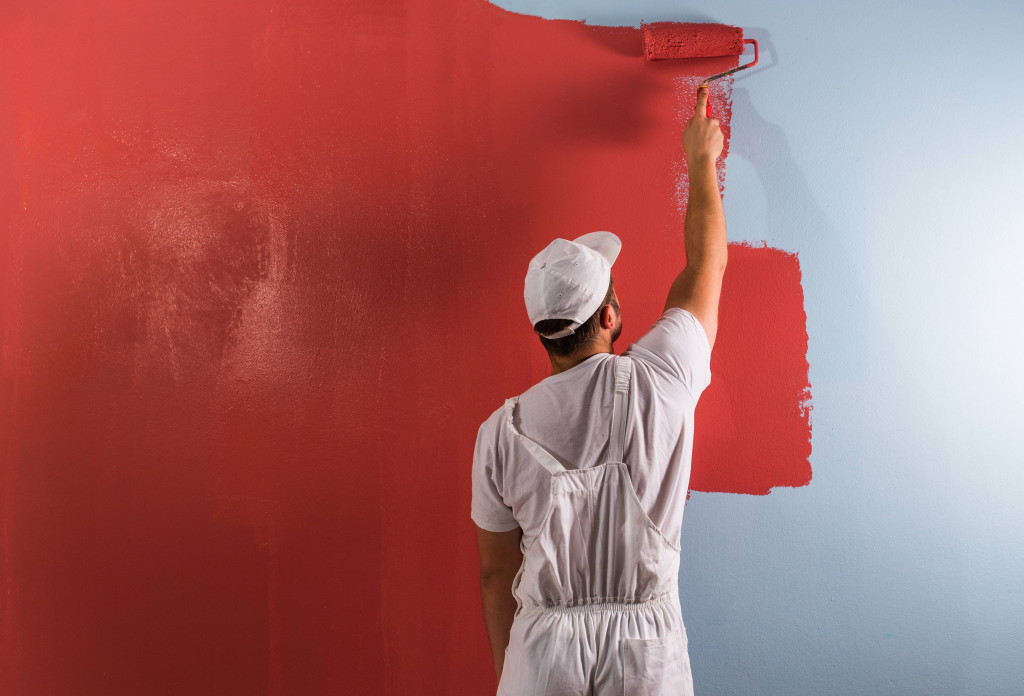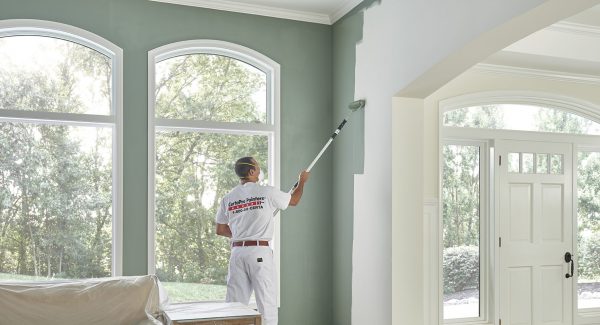Upgrade Your Home Interior with professional Tips from a reliable corpus christi paint store
Exploring the Different Kinds Of Paint: A Guide for each Task
Exploring the various kinds of paint is necessary for achieving the wanted outcome in any type of job. From water-based options that offer convenience to oil-based paints recognized for their longevity, each selection has its benefits. Specialized paints can add unique appearances or finishes, while environmentally friendly options provide to those seeking sustainability. Recognizing these distinctions can significantly affect the success of a paint venture. What aspects should one take into consideration when making the ideal option?
Recognizing Paint Kinds: Oil-Based vs. water-based
Paint types can considerably impact a job's result, and comprehending the differences in between water-based and oil-based paints is vital for informed decision-making. Water-based paints, usually described as latex paints, are composed of water as the key solvent. They dry quickly, release less unstable organic substances (VOCs), and are simple to tidy up with soap and water. This makes them a prominent selection for indoor applications and atmospheres where air top quality is a worry.
In comparison, oil-based paints make use of organic solvents, providing a resilient, shiny surface suitable for surfaces exposed to tear and use, such as trim and cupboards. They take longer to dry, need mineral spirits for cleanup, and have a stronger smell. paint store corpus christi tx. Selecting in between these 2 kinds depends upon the certain needs of the job, thinking about variables such as wanted coating, application environment, and simplicity of upkeep. Each kind has distinctive benefits and constraints, directing the selection procedure
The Finish Issues: Choosing Between Matte, Satin, and Gloss
When selecting a paint surface, the choice between matte and shiny alternatives significantly influences both aesthetic appeals and functionality. Matte finishes use a refined, non-reflective look that can conceal surface area blemishes, while glossy surfaces provide sturdiness and simplicity of cleansing. Recognizing the advantages and factors to consider of each can help in making an educated choice for any paint project.
Matte End Up Advantages
Numerous house owners dispute the merits of different coatings, matte paint uses unique advantages that make it a prominent selection for both interior and outside applications. Among the primary advantages of matte coating is its ability to conceal surface area imperfections, producing a smoother look on wall surfaces. This quality is particularly advantageous in older homes or rooms with uneven surface areas. In addition, matte paint takes in light instead of showing it, which can improve the visual of a room by providing a more innovative and low-key appearance. Matte coatings are often simpler to touch up than glossier alternatives, as they can blend extra effortlessly when applied over existing paint. In general, matte paint is an outstanding selection for those seeking a fine-tuned and elegant coating.
Glossy Complete Considerations
A glossy finish can drastically change the assumption of a room, supplying a reflective and streamlined quality that boosts both shade vibrancy and light within an area. This coating is usually favored for high-traffic locations and surfaces like kitchens and washrooms, where toughness and ease of cleaning are essential. Its reflective nature can highlight blemishes on walls, making correct surface preparation crucial. Glossy paints also tend to show smudges and finger prints much more conveniently, requiring routine maintenance. Furthermore, lighting plays a considerable function; in intense atmospheres, a glossy finish may create glare, influencing the total visual. Careful consideration of the certain application and atmosphere is crucial when choosing a glossy surface for any job.
Specialty Paints: When to Utilize Textured or Chalk Paint
Specialty paints, such as distinctive and chalk paint, deal distinct aesthetic and practical benefits that can enhance numerous surfaces. Textured paint is ideal for developing depth and measurement on walls, concealing blemishes while adding a three-dimensional feeling. It is especially useful in high-traffic areas where durability and aesthetic rate of interest are important.

Both kinds of specialized paints can transform areas, yet selecting the best one depends on the desired effect and surface area requirements. Distinctive paint may suit bigger locations, while chalk paint can rejuvenate smaller sized items, showcasing creativity and personal design in any type of job.
Outside Paints: Shielding Your Surfaces From the Components
Outdoor paints are crucial for protecting surface areas against different weather. Understanding their climate resistance features, correct surface area preparation demands, and effective application methods can significantly boost sturdiness and performance. This area will detail key factors to consider for picking and using exterior paints properly.
Weather Condition Resistance Includes
Climate resistance is a necessary function of outdoor paints, as it determines exactly how well surface areas can withstand the rough components of nature. Top quality outside paints are developed to withstand damage from UV rays, moisture, and temperature level fluctuations. UV resistance assurances colors stay vivid over time, preventing fading and discoloration. Dampness resistance safeguards against mold and mildew and mildew, which can jeopardize the integrity of surfaces. In addition, paints with exceptional temperature level resistance can contract and broaden without breaking, keeping their protective top qualities. When choosing outside paints, it is crucial to think about these climate resistance features, as they contribute to the durability and toughness of coloured surface areas, ensuring they continue find this to be visually pleasing and functional in spite of exposure to the aspects.
Surface Area Preparation Requirements
Correct surface area prep work is a fundamental action in accomplishing the most effective outcomes with outdoor paints. To assure excellent bond and toughness, surfaces must be extensively cleansed, eliminating grease, mildew, and dirt. This can be achieved making use of a pressure washing machine or a scrub brush with an ideal cleansing solution. As soon as cleansed, surfaces ought to be checked for any peeling or flaking paint, which need to be scuffed away to produce a smooth foundation. Fixing any type of splits or holes is likewise essential, as these can allow wetness seepage. Additionally, sanding rough locations promotes far better paint attachment. Using a primer suited for outdoor usage can improve the paint's efficiency, ensuring a resilient finish that withstands the components. Proper preparation is vital to a successful exterior painting job.
Application Methods Tips
While using outside paints, it is necessary to use effective methods that guarantee surfaces are well-protected against the aspects. Initially, select the ideal day for paint; reduced humidity and light temperatures enhance bond and drying. Prepping the surface area thoroughly-- cleansing, sanding, and priming-- ensures better paint adhesion and durability. Utilizing top quality brushes or rollers can offer a smoother coating, while spray paint may cover huge locations successfully. Using paint in thin, even layers avoids drips and runs. It is suggested to comply with supplier instructions regarding drying out times in between layers. Confirm proper air flow throughout application to help with drying out and minimize exposure to fumes. These techniques substantially improve the durability and performance of outside paint.
Eco-Friendly Options: Low-VOC and Zero-VOC Paints
As consumers end up being significantly conscious of the ecological influence of their choices, zero-voc and low-voc paints have become prominent choices. These paints are created to have less volatile organic compounds (VOCs), which are chemicals that can vaporize right into the air and contribute to air pollution and health issue. Low-VOC paints typically include a restricted quantity of VOCs, while zero-VOC paints have minimal levels, making them much safer for both interior and exterior usage.
The advantages of making use of low-VOC and zero-VOC paints extend beyond ecological factors to consider; they also enhance interior air quality, lowering the threat of respiratory system concerns and allergies. Many manufacturers now supply a range of colors and finishes in eco-friendly options, making it easier for customers to find ideal items for their find out this here jobs. By selecting these paints, people can add to a much healthier atmosphere while still attaining the visual they desire in their spaces.
Tools and Techniques for a Remarkable Application
Accomplishing a perfect paint application requires the right tools and strategies, which can significantly improve the result. Choosing the appropriate brush or roller is vital; brushes work well for edges and complex areas, while rollers cover bigger surface areas effectively. Utilizing high-quality materials guarantees better paint circulation and reduces streaks. For suitable results, surface area preparation is essential. This consists of cleaning, sanding, and priming surfaces to advertise adhesion.
Technique additionally plays a substantial function. The "W" technique with a roller aids to equally disperse paint, while long, smooth strokes with a brush avoid noticeable lines. Operating in areas enables far better control and blending. Additionally, using slim layers is more effective to thick layers, decreasing the threat of drips and unequal textures. Preserving a wet edge throughout application aids accomplish smooth changes in between areas. By incorporating these devices and techniques, one can accomplish a specialist and refined surface.
Tips for Preserving and Caring for Your Painted Surfaces
Appropriate maintenance and care of colored surfaces can substantially prolong their life expectancy and protect their look. Routine cleansing is crucial; making use of a soft fabric or sponge with moderate soap and water can remove dust and dirt without harming the paint. It is suggested to avoid abrasive cleansers or rubbing pads, as these can damage the surface. Additionally, using a fresh layer of paint every couple of years can invigorate the color and shield versus wear.
For outside surfaces, inspecting for indications of peeling off or fading consistently is vital. Quickly addressing any kind of concerns prevents more damage. In locations prone to moisture, such as shower rooms, using mold-resistant paint and ensuring proper ventilation can assist preserve the stability of the paint. Using safety coatings can secure against UV rays and spots, making certain that painted surface areas continue to be attractive and dynamic for years to come, inevitably boosting the total visual of the area.

Often Asked Questions
Can I Mix Different Types of Paint Together?
Mixing different kinds of paint is usually not suggested, as it can bring about problems like bad adhesion, additional hints irregular appearance, or unexpected chemical responses. It's finest to make use of suitable paints for optimal outcomes and sturdiness.

Exactly how Do I Appropriately Shop Extra Paint?
To correctly keep remaining paint, seal the container firmly, tag it with the day and shade, and maintain it in an amazing, completely dry place away from direct sunlight and severe temperatures for suitable conservation.
What Is the most effective Way to Throw Away Extra Paint?
The most effective way to throw away unused paint is to examine regional regulations, as many locations have actually designated harmful waste facilities. Consider donating functional paint to community organizations or colleges for their projects.
Just How Can I Tell if Paint Is Still Good to Make Use Of?
To identify if paint is still great, analyze its scent, color, and uniformity. If it shows up separated, has an undesirable smell, or shows significant adjustments in texture, it's most likely no more usable.
Are There Age Restrictions for Getting Paint Products?
In lots of regions, there are no particular age limitations for purchasing paint items. However, some stores might need customers to be at the very least 18 years old, especially for items consisting of solvents or hazardous products.
Paint kinds can substantially impact a project's outcome, and comprehending the distinctions between oil-based and water-based paints is important for notified decision-making. Water-based paints, often referred to as latex paints, are composed of water as the main solvent. In comparison, oil-based paints use natural solvents, supplying a resilient, shiny surface ideal for surface areas subjected to wear and tear, such as trim and cabinets. Specialized paints, such as textured and chalk paint, offer one-of-a-kind aesthetic and practical benefits that can enhance various surface areas. In locations prone to wetness, such as restrooms, making use of mold-resistant paint and ensuring proper ventilation can assist maintain the stability of the paint.